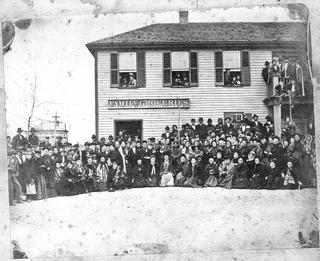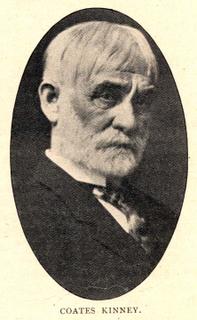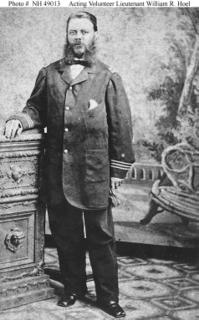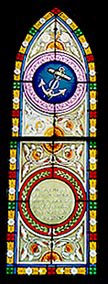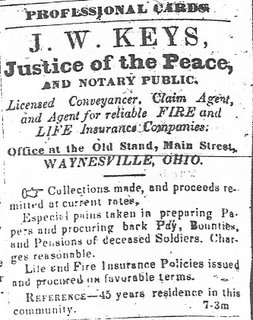William Henry Venable
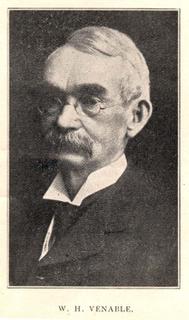 William Henry Venable, the son of William and Hannah (Baird) Venable, was born three miles southwest of Waynesville, Ohio (Warren Co.) on April 29, 1836. Friend William Venable was a Quaker and an abolitionist, a surveyor, a teacher and a farmer. The couple with their four children moved to "Venable Station", a short distance from Ridgeville, Ohio when William Henry was six years old. Living near Springboro, he had access to the Springboro lending library. Brilliant and erudite, he quickly out grew local schools and libraries and desired a higher education. To earn money for his education he began teaching in November of 1854 in a one-room schoolhouse at Sugar Grove near Waynesville. He was paid 60¢ a day. He received private instruction from Dr. Alfred Holbrook who was the principal of the National Normal School located in Lebanon, Ohio. W. H. Venable also attended the Normal School as a student and later was a teacher in the same institution (intermittently from 1855-1861). He was versatile and eclectic in his interests. As a teenager he began writing for local newspapers and became an authority on the literary history of the Miami Valley. He married Mary Ann Vater, the daughter of Thomas and Elinor Palmer Vater of London, on December 30th, 1861 in Indianapolis, Indiana. They had eight children:
William Henry Venable, the son of William and Hannah (Baird) Venable, was born three miles southwest of Waynesville, Ohio (Warren Co.) on April 29, 1836. Friend William Venable was a Quaker and an abolitionist, a surveyor, a teacher and a farmer. The couple with their four children moved to "Venable Station", a short distance from Ridgeville, Ohio when William Henry was six years old. Living near Springboro, he had access to the Springboro lending library. Brilliant and erudite, he quickly out grew local schools and libraries and desired a higher education. To earn money for his education he began teaching in November of 1854 in a one-room schoolhouse at Sugar Grove near Waynesville. He was paid 60¢ a day. He received private instruction from Dr. Alfred Holbrook who was the principal of the National Normal School located in Lebanon, Ohio. W. H. Venable also attended the Normal School as a student and later was a teacher in the same institution (intermittently from 1855-1861). He was versatile and eclectic in his interests. As a teenager he began writing for local newspapers and became an authority on the literary history of the Miami Valley. He married Mary Ann Vater, the daughter of Thomas and Elinor Palmer Vater of London, on December 30th, 1861 in Indianapolis, Indiana. They had eight children: - Russell Vernon Venable
- Victor Venable
- Mary Venable
- William Mayo Venable
- Bryant Venable
- Emerson Venable
- Una Venable.
William H. Venable received an honorary degree of Master of Arts from De Pauw University in 1864 and an honorary degree of Doctor of Laws from Ohio University in 1886. He was the principal of the Jennings Academy at Vernon, Indiana for about a year. He also was one of the editors of the Indiana School Journal. For a quarter of a century he taught at the Chickering Institute in Cincinnati. He became the principal and proprietor of this school in 1881. He was a popular guest speaker at Miami Valley College and other local colleges. Beginning in 1886 he spent three years writing and lecturing in cities and towns in Ohio, Indiana, Pennsylvania, Kentucky, and West Virginia. He was famous for his humorous lecture, “Thomas Tadmore”, about the pathos of boy life. During the last decade of the 19th century he actively promoted a liberal reform of education as the chairman of the Department of English at both Hughes and Walnut Hills High Schools in Cincinnati. He authored 22 textbooks of poetry, fiction, philosophy, essays, as well as annotations of English literature. He wrote A School History of the United States, which became a standard textbook in Ohio and two volumes of poetry: “June on the Miami” and “Melodies of the Heart”. The poem he is most known for is “The Teacher’s Dream”.
From 1875 on the Venable family lived at "Diana Place" a suburban homestead east of Cincinnati proper in the hills overlooking the Ohio River. William Henry Venable died in 1920 and is buried in Cincinnati. See, Historical Collections of Ohio in Two Volumes: An Encyclopedia of the State, Volume II, by Henry Howe (Norwalk, Ohio: The Laning Printing Co, Public Printers, 1896) pp. 772-775.
Other books written by W. H. Venable are: “Amateur Actor, A Collection” (ed.) in 1874, “Dramatic Scenes from the Best Authors” in 1874, “The School Stage” in 1873, “Footprints of the Pioneers in the Ohio Valley” in 1888, “Down South Before the War” in 1889, “Beginnings of Literary Culture in the Ohio Valley” in 1891, “John Hancock, Educator” in 1892, "Tales from Ohio History", in 1896, “Selections from Burns, Byron and Wordsworth” in 1898, “The Last Flight” in 1894, “Life and Poems of General W. H. Lytle” in 1894, "Let Him First be a Man” in 1894, “A Dream of Empire, or the House of Blennerhasset” in 1901, “Tom Tad, a Novel” in 1902, “The Literature of Ohio Centennial Sketch” in 1903 and “Saga of the Oak, and Other Poems” in 1903.
- John Quincy Venable
- Sarah Newell Venable (1833)
- William Henry Venable (April 29th, 1836)
- Cynthia Jane Venable (1839)
- (1843).
William Henry Venable refers to his father in the short story, “Going down to Cincinnati: A Boy’s Journey Half a Century Ago”:
“The shriek of the locomotive was unheard in the woods when my father surveyed uncleared acres near the Little Miami, and aided by neighbors with handspike and ax, raised a rustic house and home, a mansion of logs chiefly ash and sassafras, or ‘sassafax’, as the word was pronounced by the farmers. Further on in the story when they have arrived in Cincinnati he says, “My father, always deeply interested in public institutions and in architecture, guided me to the principal hotels, the courthouse, and the churches, not omitting the Synagogue. He took particular pleasure in pointing out St. Xavier’s College and St. Peter’s Cathedral, and, though not a Catholic went with me to see Bishop Purcell. Nor did he deprive me of pleasures less serious. At nightfall he conducted me, in the glare of street-lamps, to auction-rooms, to gratify my curiosity with sights and sounds the like of which the farm never saw or heard. But the opportunity, which, in common with thousands of country boys, I could least think of foregoing, was that of visiting Monsieur J. Dorfeuille’s Western Museum, of which I had heard many a wonderful tale.” On the second evening of their stay in Cincinnati, “my father, dear comrade, took me to the theater, the Old National on Sycamore Street. We sat in the front row of the balcony. There was a double bill, the opening drama being John Howard Payne’s tragedy, ‘Brutus; or the Fall of Tarquin’” (The Hesperian Tree: A Souvenir of the Ohio Valley edited by John James Piatt [North Bend, Ohio: John Scott and Co., 1900), pp. 127-139).
A cousin of William Henry Venable, William Wallace Baird, the son of his uncle Bedent Baird, Jr., was employed at Miami Valley College and was in charge of the mechanical department from 1872-1874 (1882 History of Warren County, Ohio [Chicago: W. H. Beers & Co., 1882], pp. 890-891).
Related families include BAIRD, BRADY, BULLA, CRALL, LIDDLE, LONGLEY, MACDONALD, MCCOY, PALMER, SUTTON, TUCKERMAN, VATER, AND WEIFFENBACH.
Also see, "William Venable Left a Legacy of Writings, Teachings" by Dallas Bogan, http://www.rootsweb.com/~ohwarren/Bogan/bogan255.htm

